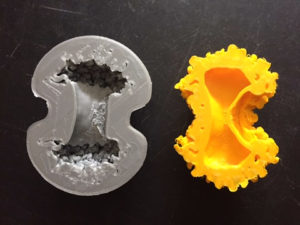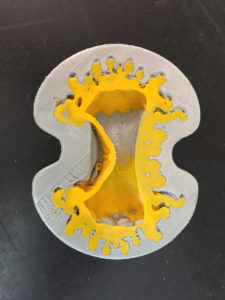
Researchers were able to analyze a bright nova explosion from V745 Sco — the third time a dramatic brightening of the system was observed, but the first they could gather extensive data. [Image: S. O’Connor – OCN. St. Georges, Bermuda]
V745 Sco, a binary star system located about 25,000 light-years from Earth, is made up of a red giant star and its small, stellar core, known as a white dwarf. The two orbit each other very closely, and as they do, material from the outer layers of the larger red giant star is pulled towards the white dwarf. This material falls onto the surface of the smaller star, which accumulates for a period of time until it triggers a bright nova explosion.
Three years ago, researchers observed the binary system fading after one of these nova explosions died out. The blast was equal to roughly 10 million trillion hydrogen bombs, causing the system to fade to 1/1000th of its brightness in optical light. Luckily, the scientists were prepared to take down any data they could get, and observed V745 Sco two weeks after the explosion in order to generate the 3D model.Representatives from Chandra X-ray Observatory explained, “Astronomers were caught by surprise when previous outbursts from this system were seen in 1937 and 1989. When the system erupted on Feb. 6, 2014, however, scientists were ready to observe the event with a suite of telescopes including the Chandra X-ray Observatory.”
While 3D printing technology plays a large part in space travel today, and could even help us survive on Mars, it’s also been successfully used before to study the stars, asteroids, and even the entire universe.
- [Images: S. Orlando (INAF-Osservatorio Astro. di Palermo) & NASA/CXC/SAO/A.Jubett et al.]
While they were analyzing the data they’d captured, the astronomers discovered that, based on the X-rays coming out of the explosion, it appeared that a majority of the ejected material was headed towards Earth. The 3D model helped them see evidence that a large disk of cool gas circling the middle of the two stars, which was released as the white dwarf pulled on gas that was flowing from the red giant, had helped shape the blast so it would concentrate in both upward and downward directions. Here’s where things get pretty interesting – a growing ring of hot gas emitting X-rays was also produced, but the X-rays being cast out by the material moving away from our planet were blocked by the material moving in the opposite direction, towards Earth, which made it seem like all of the material was headed straight forward.
While all of this sounds pretty impressive, the researchers determined that the amount of ejected mass was still smaller than the amount necessary to trigger an explosion. So, the binary system can still accumulate material and create explosions, without all of the material being blasted away, and if enough of this material builds up, the white dwarf star could undergo a thermonuclear explosion large enough to wipe it out; astronomers call these Type Ia supernovas, and use them as “cosmic distance markers to measure the expansion of the Universe.”
The team published their findings in a paper, titled “Origin of asymmetries in X-ray emission lines from the blast wave of the 2014 outburst of nova V745 Sco,” in the Monthly Notices of the Royal Astronomical Society journal; co-authors include Salvatore Orlando from the Palermo Astronomical Observatory, Jeremy Drake with the Harvard-Smithsonian Center for Astrophysics, and Marco Miceli from the University of Palermo.The paper’s abstract explains, “The symbiotic nova V745 Sco was observed in outburst on 2014 February 6. Its observations by the Chandra X-ray Observatory at days 16 and 17 have revealed a spectrum characterized by asymmetric and blue-shifted emission lines. Here we investigate the origin of these asymmetries through three-dimensional hydrodynamic simulations describing the outburst during the first 20 days of evolution. The model takes into account thermal conduction and radiative cooling and assumes a blast wave propagates through an equatorial density enhancement. From the simulations, we synthesize the X-ray emission and derive the spectra as they would be observed with Chandra.”
- [Images: S. Orlando (INAF-Osservatorio Astro. di Palermo) & NASA/CXC/SAO/A.Jubett et al.]
According to the Chandra X-ray Observatory, the 3D printed version of the explosion model was simplified and printed in two parts, offering a tactile look at the blast wave, which was printed in gray PLA and kind of resembles a brain, and the ejected material from the white dwarf, printed in yellow PLA. It took 9.5 hours to 3D print the blast wave on a Da Vinci 3D printer, and 24 hours to print it on an Ultimaker 3. It took nearly the same amount of time – 20 hours – to print the yellow ejected material on the Ultimaker 3, but only 4 hours to print it out on the Da Vinci. You can also 3D print your own stellar blast, with stl files available here for the Ejecta and here for the Blast wave.
Discuss this story and other 3D printing topics at 3DPrintBoard.com, or share your thoughts in the Facebook comments below.
[Source: Space.com]Subscribe to Our Email Newsletter
Stay up-to-date on all the latest news from the 3D printing industry and receive information and offers from third party vendors.
You May Also Like
Precision at the Microscale: UK Researchers Advance Medical Devices with BMF’s 3D Printing Tech
University of Nottingham researchers are using Boston Micro Fabrication‘s (BMF) 3D printing technology to develop medical devices that improve compatibility with human tissue. Funded by a UK grant, this project...
3D Printing Webinar and Event Roundup: April 21, 2024
It’s another busy week of webinars and events, starting with Hannover Messe in Germany and continuing with Metalcasting Congress, Chinaplas, TechBlick’s Innovation Festival, and more. Stratasys continues its advanced training...
3D Printing Webinar and Event Roundup: March 17, 2024
It’s another busy week of webinars and events, including SALMED 2024 and AM Forum in Berlin. Stratasys continues its in-person training and is offering two webinars, ASTM is holding a...
3D Printed Micro Antenna is 15% Smaller and 6X Lighter
Horizon Microtechnologies has achieved success in creating a high-frequency D-Band horn antenna through micro 3D printing. However, this achievement did not rely solely on 3D printing; it involved a combination...




































